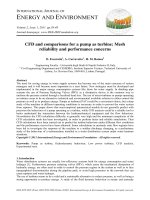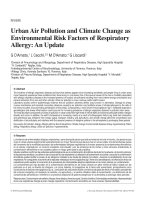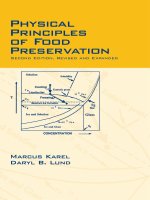Temperature terminology
Bạn đang xem bản rút gọn của tài liệu. Xem và tải ngay bản đầy đủ của tài liệu tại đây (765.7 KB, 53 trang )
1
373 100° 672 212°
273 0° 492 32°
0 -273° 0 -460°
°C = 5/9 (°F - 32 )
°F = 9/5 (°C) + 32
K = 273 +°C
R = 460 + °F
Kelvin & Rankine are
Kelvin & Rankine are
absolute scales
absolute scales
BOILING POINT
OF WATER
ICE POINT
ABSOLUTE
ZERO
kELVIN CELSIUS RANKINE FAHRENHEIT
Temperature
Temperature
terminology
terminology
Temperature Measurement Scales
Temperature Measurement Scales
2
Temperature
Temperature
Measurement
Measurement
Technology
Technology
METALS change in VOLUME in response to change in
TEMPERATURE & DISSIMILAR METAL STRIPS having different
COEFFICIENT of VOLUME CHANGE.
Example: Bimetallic Thermometer
Thermocouple (discussed later)
Bimetallic Thermometer
The degree of deflection of 2 dissimilar metals is proportional to
the change in temperature.
One end of the spiral (wounded from a long strip of material) is
immersed in the process fluid and the other end attached to a
pointer.
3
Example: Vapour Pressure Thermometer
A bulb connected to a small bore capillary which is
connected to an indicating device.
Indicating device consist of a spiral bourdon gauge
attached to a pointer.
The bulb is filled with a volatile liquid and the entire
mechanism is gas tight and filled with gas or liquid
under pressure.
Basically the system converts pressure at constant
volume to a mechanical movement.
Temperature Measurement
Temperature Measurement
Technology
Technology
Expansion & Contraction of FILLED THERMAL
FLUIDS
4
Example: Quartz Crystal Thermometers
Quartz crystal hermetically sealed in a stainless
steel cylinder, similar to a thermocouple or RTD
sheath but , larger.
Quartz crystal converts temperature into a
frequency.
They provide good accuracy and response time with
excellent stability.
Hence, this technology is expensive.
Temperature Measurement
Temperature Measurement
Technology
Technology
Change in RESONANT FREQUENCY of crystal in
response to change in TEMPERATURE
5
Example: Radiation Pyrometry
Infers temperature by collecting thermal radiation from
process and focusing it on a photon detector sensor.
The sensor produces and output signal as radiant energy
striking it releases electrical charges.
Temperature Measurement
Temperature Measurement
Technology
Technology
Collection of THERMAL RADIATION from an
object subjected to HEAT
6
Example: Thermistors
RTD (discussed later)
Thermistors
Semi-conductors made from specific mixtures of pure oxides of
nickel, manganese, copper, cobalt, and other metals sintered at
very high temperature.
Used with Wheatstone Bridge which amplifies small change in
resistance - in a simple circuit with a battery and a micro-ammeter.
• Stability -
• Linearity -
• Slope of Output -
Temperature Measurement
Temperature Measurement
Technology
Technology
Change in RESISTANCE with response to change in
TEMPERATURE
Moderate
Poor (Logarithmic)
Negative
7
Temperature Sensors
Temperature Sensors
RTDs
RTDs
What is an RTD ?
–
–
R
Resistance
T
Temperature
D
Detector
Platinum
resistance changes
with temperature
Rosemount’s
Series 78, 88
Rosemount’s
Series 68, 58
Series 65
Two common types of RTD elements:
Wire-wound sensing element
Thin-film sensing element
» Operation depends on inherent characteristic of metal
(Platinum usually): electrical resistance to current flow
changes when a metal undergoes a change in
temperature.
» If we can measure the resistance in the metal, we know
the temperature!
8
Temperature Sensors
Temperature Sensors
RTDs
RTDs
How does a RTD works?
– Resistance changes are Repeatable
– The resistance changes of the platinum wiring can be
approximated by an ideal curve -- the IEC 751
0
50
100
150
200
250
300
350
-200 0 200 400 600 800
Resistance (Ohms)
Temperature (
o
C)
o
C Ohms
0 100.00
10 103.90
20 107.79
30 111.67
International Resistance
vs. Temperature Chart:
IEC 751
IEC
751
IEC 751 Constants are :- A = 0.0039083, B = - 5.775 x 10
-7
,
If t>=0°C, C=0, If t<0, C = - 4.183 x 10
-12
Example:
R
T
= R
0
[1 + At + Bt
2
+ C(t-100)t
3
]
= 103.90
9
°C -100 0 100 200 300 400 500 600 700
°F -148 32 212 392 572 762 932 1112 1292
Temperature
Relative Resistance (R
T
/ R
0
)
0
1
2
3
4
5
6
Platinum
Balco
Nickel
Thermistor
Most linear
Most Repeatable
Most Stable
Positive Slope
Platinum vs other RTD materials
Temperature Sensors
Temperature Sensors
RTDs
RTDs
10
Sensing Element
(i.e. wire-wound, thin film)
Red
Red
White
Red
White
White
Black
Green
Green
White
Why use a 2-, 3-, or 4- wire RTD?
– 2-wire: Lowest cost -- rarely used due to high error from lead wire
resistance
– 3-wire: Good balance of cost and performance. Good lead wire
compensation.
– 4-wire: Theoretically the best lead wire compensation method
(fully compensates); the most accurate solution. Highest cost.
4-wire RTD
Typically use copper wires for
extension from the sensor
Temperature Sensors
Temperature Sensors
RTDs
RTDs
11
2-wire or 4-wire RTD ?
• If the sensing element is at 20°C,
– What would be the temperature measured at the end of the
extension wire using a 2-wire assembly
– What would be the temperature measured at the end of the
extension wire using a 4-wire assembly
Red
White
2-wire RTD
6 metres of copper extension
wire, lead resistance =
0.06 ohms/metre
(1 ohm = 2.5 deg C approx)
Sensing Element
(I.e. wire-wound, thin film)
Temperature Sensors
Temperature Sensors
RTDs
RTDs
Error for a 2 wire assembly
0.06 x 6 x 2 = 0.72 ohms or 1.8Deg C
This means that the temperature
measured at the end of the cable
would be 21.8 Deg C
Error for a 4 wire assembly
As the lead resistances can be
accounted for the temperature
measured at the end of the cable
would be 20.0 Deg C
12
• Supports Hot Backup capability
• Dual element adds only $5 over single element
RTD
» Reduce the risk of a temperature point failure
• Supports Differential Temperature Measurement
Dual Element RTDs available
Red
Red
White
Black
Red
Red
Green
Blue
Blue
White
Dual Element:
Two 3-wire RTDs
Temperature Sensors
Temperature Sensors
RTDs
RTDs
13
Temperature Sensors
Temperature Sensors
RTDs
RTDs
14
Temperature Sensors
Temperature Sensors
RTDs
RTDs
15
IEC 751 Curve
The IEC 751 standard curve (programmed into all our
transmitters) describes an IDEAL Resistance vs Temperature
relationship for Pt100 = 0.00385 RTDs.
TEMPERATURE (
o
C)
RESISTANCE (OHMS)
Class B Tolerance
Standard IEC 751 Curve
Class B Tolerance
Standard IEC 751 Curve
Class B Tolerance
0.8
o
C at -100
o
C
0.3
o
C at 0
o
C
0.8
o
C at 100
o
C
1.3
o
C at 200
o
C
1.8
o
C at 300
o
C
2.3
o
C at 400
o
C
(Sensor Interchangeability Error)
The goal is to find out what the real RTD
curve looks like, and reprogram the
transmitter to use the “real” curve!
Every RTD is slightly
different - they’re not ideal!
Every RTD is slightly
different - they’re not ideal!
Temperature Sensors
Temperature Sensors
RTDs
RTDs
16
Accuracy
Temperature Resistance Grade A Grade A Grade B Grade B
°C Ohms ± °C ± Ohms ± °C ± Ohms
-200 18.52 0.55 0.24 1.3 0.56
-100 60.26 0.35 0.14 0.8 0.32
0 100.00 0.15 0.06 0.3 0.12
100 138.51 0.35 0.13 0.8 0.30
200 175.85 0.55 0.2 1.3 0.48
300 212.05 0.75 0.27 1.8 0.64
400 247.09 0.95 0.33 2.3 0.79
500 280.98 1.15 0.38 2.8 0.93
600 313.71 1.35 0.43 3.3 1.06
Temperature Sensors
Temperature Sensors
RTDs
RTDs
• EN 60751 Tolerances
– Pt 100, = 0.00385
17
Your customer is operating a process at 100°C
and is using a Platinum RTD...
What is the maximum error that will be
introduced into the temperature measurement
from Sensor Interchangeability?
+/-0.35 deg C for Class A,
+/-0.8 deg C for Class B
Fortunately, Sensor Interchangeability Error can
be reduced or eliminated by Sensor Matching!
Quiz: - Find the Interchangeability Error
Temperature Sensors
Temperature Sensors
RTDs
RTDs
18
o
C Ohms
0.0 99.997
1.0 100.38
2.0 100.77
3.0 101.16
Customer Receives
RTD-specific Resistance
vs. Temperature Chart:
Data generated
(RTD “characterized”)
Temperature Bath
- One temperature
- Multiple temperatures
Temperature Sensors
Temperature Sensors
RTDs
RTDs
What is RTD Calibration?
– The real RTD curve is found by “characterizing” an
RTD over a specific temperature range or point.
» Temperature Range Characterization
Calibration certificate provided with sensor
» Temperature Point Characterization
Calibration certificate provided with sensor
19
Transmitter reading does NOT equal process temperature.
212
212
°
°
F
F
Process
Temperature
138.8
138.8
RTD
Resistance:
Transmitter
Input:
R vs. T Curve of
REAL RTD
REAL RTD
If we could tell the transmitter the shape of the “Real” RTD curve,
we could eliminate the interchangeability error!
The curve programmed into
every xmtr is the
IEC 751
IEC 751
-
-
the
the
“
“
Ideal
Ideal
”
”
RTD curve
RTD curve
With a Real RTD, the Resistance vs. Temperature
relationship of the sensor is NOT the same curve that
is programmed into the transmitter
The Transmitter
Translates 138.8 into
213.4
213.4
°
°
F
F
Using the IEC 751
Transmitter curve does NOT match RTD curve.
Outcome ??
Outcome ??
Temperature Sensors
Temperature Sensors
RTDs
RTDs
20
Pt100 a385 Temp vs Resistance
real sensor
curve
standard
IEC 751 curve
sensor matched
curve in tx
Resistance
Temperature
A fourth order equation can be programmed into Smart
Transmitters to follow non-ideal sensor curvature; simply enter
four constants using 275.
Transmitter reading equals process temperature
Transmitter curve is perfectly matched to “ideal” RTD curve
Outcome ??
Outcome ??
R
o
= 99.9717
= 0.00385367
= 0.172491
= 1.61027
Tag
Tag
Temperature Sensors
Temperature Sensors
RTDs
RTDs
Sensor Matching - eliminates sensor interchangeability error
21
Temperature Sensors
Temperature Sensors
RTDs
RTDs
R
t
= R
o
+ R
o
[t-(0.01t-1)(0.01t)-(0.01t-1)(0.01t)
3
]
R
t
= Resistance at Temperature t (°C)
R
o
= Sensor-Specific Constant (Resistance at t = 0°C)
= Sensor-Specific Constant
= Sensor-Specific Constant
= Sensor-Specific Constant (If t >=0°C, then = 0)
IEC 751 Curve
Temperature (
o
C)
Resistance ()
Class B
Tolerance
• The transmitter does not use
the IEC 751 standard curve.
• Instead, the Callendar-Van
Dusen constants can be used in
the equation below to create
the true sensor curve.
• Or, the actual IEC 751
constants A,B, and C can be
used in the IEC 751 equation if
known.
• The transmitter does not use
the IEC 751 standard curve.
• Instead, the Callendar-Van
Dusen constants can be used in
the equation below to create
the true sensor curve.
• Or, the actual IEC 751
constants A,B, and C can be
used in the IEC 751 equation if
known.
Sensor Matching - Mapping the Real RTD Curve
4th Order
Callendar-Van
Dusen Equation
22
0
50
100
150
200
250
300
350
400
-200 0 200 400 600 800
A 1-point trim shifts the ideal
curve up or down based on
the single characterized point
Temperature (°C)
Resistance ()
A 2-point trim shifts the ideal curve
up or down AND changes the slope
based on the two characterized points
Temperature (°C)
Resistance ()
0
50
100
150
200
250
300
350
400
-200 0 200 400 600 800
One Point Trim
Use with X9
(or X8)
Two Point Trim
Use with X8
Temperature Sensors
Temperature Sensors
RTDs
RTDs
Sensor Trimming
– Data from the resistance vs. temp. chart can be used to
reduce sensor interchangeability error
– Use one or two points to trim the sensor to a transmitter
23
Process
Process
Temperature
Temperature
Hot junction
– Two dissimilar metals joined at a “Hot” junction
Cold junction
+
-
MV
– The wires are connected to an instrument (voltmeter) that
measures the potential created by the temperature
difference between the two ends.
DT
The junction of two dissimilar metals
creates a small voltage output
proportional to temperature!
What is a Thermocouple ?
Temperature Sensors
Temperature Sensors
Thermocouples
Thermocouples
In 1831, Seebeck
discovered that an
electric current
flows in a closed
circuit of two
dissimilar metals
when one of the two
junction is heated
with respect to the
other.
24
How does a Thermocouple work ?
– The measured voltage is proportional to the
temperature
temperature
difference
difference between the hot and cold junction! (T
2
- T
1
) =T.
+
-
MV
Heat
Hot junction
Cold junction
o
C Millivolts
0 0.000
10 0.591
20 1.192
30 1.801
Thermoelectric Voltage
vs. Temperature Chart:
TYPE E THERMOCOUPLE
T
-20
0
20
40
60
80
-500 0 500 1000
Voltage (mV)
Temperature (
o
C)
IEC
584
Measurement
Measurement
Junction
Junction
T
T
2
2
Reference
Reference
Junction
Junction
T
T
1
1
Temperature Sensors
Temperature Sensors
Thermocouples
Thermocouples
25
Temperature Sensors
Temperature Sensors
Thermocouples
Thermocouples









